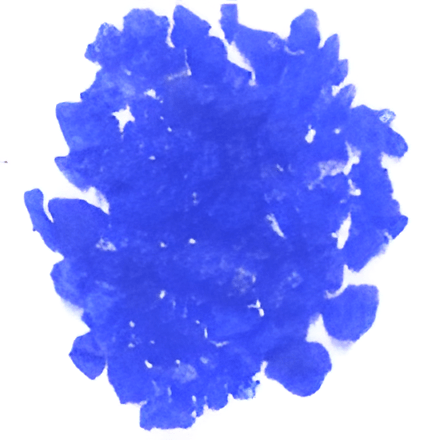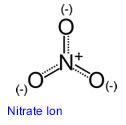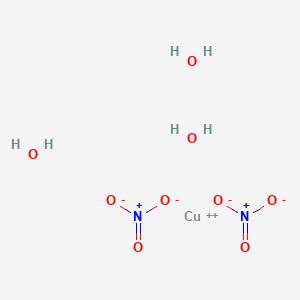SECTION 1. IDENTIFICATION
Product Name: Copper(II) Nitrate Trihydrate
Product Number: All applicable American Elements product codes, e.g. CU2-NAT-02-P.3HYD
, CU2-NAT-03-P.3HYD
, CU2-NAT-04-P.3HYD
, CU2-NAT-05-P.3HYD
CAS #: 10031-43-3
Relevant identified uses of the substance: Scientific research and development
Supplier details:
American Elements
10884 Weyburn Ave.
Los Angeles, CA 90024
Tel: +1 310-208-0551
Fax: +1 310-208-0351
Emergency telephone number:
Domestic, North America: +1 800-424-9300
International: +1 703-527-3887
SECTION 2. HAZARDS IDENTIFICATION
Classification of the substance or mixture
GHS Classification in accordance with 29 CFR 1910 (OSHA HCS)
Oxidizing solids(Category 2), H272
Acute toxicity, Oral(Category 4), H302
Skin irritation(Category 2), H315
Serious eye damage(Category 1), H318
Acute aquatic toxicity(Category 1), H400
GHS Label elements, including precautionary statements
Pictogram
Signal word
Danger
Hazard statement(s)
H272
May intensify fire; oxidizer.
H302
Harmful if swallowed.
H315
Causes skin irritation.
H318
Causes serious eye damage.
H400
Very toxic to aquatic life.
Precautionary statement(s)
P210
Keep away from heat.
P220
Keep/Store away from clothing/ combustible materials.
P221
Take any precaution to avoid mixing with combustibles.
P264
Wash skin thoroughly after handling.
P270
Do not eat, drink or smoke when using this product.
P273
Avoid release to the environment.
P280
Wear protective gloves/ eye protection/ face protection.
P301 + P312 + P330
IF SWALLOWED: Call a POISON CENTER/doctor if you feel unwell.
Rinse mouth.
P302 + P352
IF ON SKIN: Wash with plenty of soap and water.
P305 + P351 + P338 + P310
IF IN EYES: Rinse cautiously with water for several minutes. Remove contact lenses, if present and easy to do. Continue rinsing. Immediately call a POISON CENTER/doctor.
P332 + P313
If skin irritation occurs: Get medical advice/ attention.
P362
Take off contaminated clothing and wash before reuse.
P370 + P378
In case of fire: Use dry sand, dry chemical or alcohol-resistant foam for extinction.
P391
Collect spillage.
P501
Dispose of contents/ container to an approved waste disposal plant.
Hazards not otherwise classified (HNOC) or not covered by GHS-none
SECTION 3. COMPOSITION/INFORMATION ON INGREDIENTS
Substances
Synonyms:Cupric nitratetrihydrate
Formula:CuN2O6· 3H2O
Molecular weight:241.60 g/mol
CAS-No.:10031-43-3
EC-No.:221-838-5
SECTION 4. FIRST AID MEASURES
Description of first aid measures
General advice
Consult a physician. Show this safety data sheet to the doctor in attendance.
Move out of dangerous area.
If inhaled
If breathed in, move person into fresh air. If not breathing, give artificial respiration. Consult a physician.
In case of skin contact
Wash off with soap and plenty of water. Consult a physician.
In case of eye contact
Rinse thoroughly with plenty of water for at least 15 minutes and consult a physician.
Continue rinsing eyes during transport to hospital.
If swallowed
Never give anything by mouth to an unconscious person. Rinse mouth with water. Consult a physician.
Most important symptoms and effects, both acute and delayed
The most important known symptoms and effects are described in the labelling (see section 2) and/or in section 11
Indication of any immediate medical attention and special treatment needed
No data available
SECTION 5. FIREFIGHTING MEASURES
Extinguishing media
Suitable extinguishing media
Use water spray, alcohol-resistant foam, drchemical or carbon dioxide.
Special hazards arising from the substance or mixture
No data available
Advice for firefighters
Wear self-contained breathing apparatus for firefighting if necessary.
Further information
Use water spray to cool unopened containers.
SECTION 6. ACCIDENTAL RELEASE MEASURES
Personal precautions, protective equipment and emergency procedures
Use personal protective equipment. Avoid dust formation. Avoid breathing vapours, mist or gas. Ensure adequate ventilation. Evacuate personnel to safe areas. Avoid breathing dust.
For personal protection see section 8.
Environmental precautions
Prevent further leakage or spillage if safe to do so. Do not let product enter drains. Discharge into the environment must be avoided.
Methods and materials for containment and cleaning up
Sweep up and shovel. Contain spillage, and then collect with an electrically protected vacuum cleaner or by wet-brushing and place in container for disposal according to local regulations (see section 13). Keep in suitable, closed containers for disposal.
Reference to other sections
For disposal see section 13.
SECTION 7. HANDLING AND STORAGE
Precautions for safe handling
Avoid contact with skin and eyes. Avoid formation of dust and aerosols.
Further processing of solid materials may result in the formation of combustible dusts. The potential for combustible dust formation should be taken into consideration before additional processing occurs.
Provide appropriate exhaust ventilation at places where dust is formed.Keep away from sources of ignition -No smoking.Keep away from heat and sources of ignition.
For precautions see section 2.
Conditions for safe storage, including any incompatibilities
Keep container tightly closed in a dry and well-ventilated place.
hygroscopic
Heat sensitive.
Moisture sensitive.
Storage class (TRGS 510):
Oxidizing hazardous materials
Specific end use(s)
Apart from the uses mentioned in section 1 no other specific uses are stipulated
SECTION 8. EXPOSURE CONTROLS/PERSONAL PROTECTION
Exposure controls
Appropriate engineering controls
Handle in accordance with good industrial hygiene and safety practice. Wash hands before breaks and at the end of workday.
Personal protective equipment
Eye/face protection
Face shield and safety glasses Use equipment for eye protection tested and approved under appropriate government standards such as NIOSH (US) or EN 166(EU).
Skin protection
Handle with gloves. Gloves must be inspected prior to use. Use proper glove removal technique (without touching glove's outer surface) to avoid skin contact with this product. Dispose of contaminated gloves after use in accordance with applicable laws and good laboratory practices. Wash and dry hands.
Body Protection
Complete suit protecting against chemicals, The type of protective equipment must be selected according to the concentration and amount of the dangerous substance at the specific workplace.
Respiratory protection
Where risk assessment shows air-purifying respirators are appropriate use a full-face particle respirator type N100 (US) or type P3 (EN 143) respirator cartridges as a backup to engineering controls. If the respirator is the sole means of protection, use a full-face supplied air respirator. Use respirators and components tested and approved under appropriate government standards such as NIOSH (US) or CEN (EU).
Control of environmental exposure
Prevent further leakage or spillage if safe to do so. Do not let product enter drains. Discharge into the environment must be avoided.
SECTION 9. PHYSICAL AND CHEMICAL PROPERTIES
Information on basic physical and chemical properties
Appearance
Form: crystalline
Colour: dark blue
Odour
No data available
Odour Threshold
No data available
pH
No data available
Melting point/freezing point
No data available
Initial boiling point and boiling range
No data available
Flash point
Not applicable
Evaporation rate
No data available
Flammability (solid, gas)
No data available
Upper/lower flammability or explosive limits
No data available
Vapour pressure
No data available
Vapour density
No data available
Relative density
No data available
Water solubility
No data available
Partition coefficient: n-octanol/water
No data available
Auto-ignition temperature
No data available
Decomposition temperature
No data available
Viscosity
No data available
Explosive properties
No data available
Oxidizing properties
The substance or mixture is classified as oxidizing with the category 2.
Other safety information
No data available
SECTION 10. STABILITY AND REACTIVITY
Reactivity
No data available
Chemical stability
Stable under recommended storage conditions.
Possibility of hazardous reactions
No data available
Conditions to avoid
Heat Avoid moisture.
Incompatible materials
Reducing agents, Organic materials, Powdered metals
Hazardous decomposition products
Hazardous decomposition products formed under fire conditions.-Nitrogen oxides (NOx), Copper oxides
Other decomposition products-No data available
In the event of fire: see section 5
SECTION 11. TOXICOLOGICAL INFORMATION
Information on toxicological effects
Acute toxicity
LD50 Oral-Rat-940 mg/kg
Inhalation: No data available
Dermal: No data available
No data available
Skin corrosion/irritation
No data available
Serious eye damage/eye irritation
No data available
Respiratory or skin sensitisation
No data available
Germ cell mutagenicity
Rat
Ascites tumor
Cytogenetic analysis
Carcinogenicity
IARC:
No component of this product present at levels greater than or equal to 0.1% is identified as
probable, possible or confirmed human carcinogen by IARC.
No component of this product present at levels greater than or equal to 0.1% is identified as
probable, possible or confirmed human carcinogen by IARC.
NTP:
No component of this product present at levels greater than or equal to 0.1% is identified as a
known or anticipated carcinogen by NTP.
No component of this product present at levels greater than or equal to 0.1% is identified as a
known or anticipated carcinogen by NTP.
OSHA:
No component of this product present at levels greater than or equal to 0.1% is identified as a
carcinogen or potential carcinogen by OSHA.
No component of this product present at levels greater than or equal to 0.1% is identified as a
carcinogen or potential carcinogen by OSHA.
Reproductive toxicity
No data available
No data available
Specific target organ toxicity -single exposure
No data available
Specific target organ toxicity -repeated exposure
No data available
Aspiration hazard
No data available
Additional Information
RTECS: GL7875000
Material is extremely destructive to tissue of the mucous membranes and upper respiratory tract, eyes, and skin., Cough, Shortness of breath, Headache, Nausea
To the best of our knowledge, the chemical, physical, and toxicological properties have not been
thoroughly investigated.
Stomach-Irregularities-Based on Human Evidence
Stomach-Irregularities-Based on Human Evidence
SECTION 12. ECOLOGICAL INFORMATION
Toxicity
No data available
Persistence and degradability
No data available
Bioaccumulative potential
No data available
Mobility in soil
No data available
Results of PBT and vPvB assessment
PBT/vPvB assessment not available as chemical safety assessment not required/not conducted
Other adverse effects
An environmental hazard cannot be excluded in the event of unprofessional handling or disposal.
Very toxic to aquatic life.
SECTION 13. DISPOSAL CONSIDERATIONS
Waste treatment methods
Product
Burn in a chemical incinerator equipped with an afterburner and scrubber but exert extra care in igniting as this material is highly flammable.
Offer surplus and non-recyclable solutions to a licensed disposal company.
Contact a licensed professional waste disposal service to dispose of this material.
Dissolve or mix the material with a combustible solvent and burn in a chemical incinerator
equipped with an afterburner and scrubber.
Contaminated packaging
Dispose of as unused product.
SECTION 14. TRANSPORT INFORMATION
DOT (US)
UN number: 1477
Class: 5.1
Packing group: II
Proper shipping name: Nitrates, inorganic, n.o.s.(Copper(II) nitrate trihydrate)
Reportable Quantity(RQ): 100lbs
Poison Inhalation Hazard: No
IMDG
UN number: 1477
Class: 5.1
Packing group: II
EMS-No: F-A,S-Q
Proper shipping name: NITRATES, INORGANIC, N.O.S.(Copper(II) nitrate trihydrate)
Marine pollutant:yes
IATA
UN number:1477
Class: 5.1
Packing group: II
Proper shipping name: Nitrates, inorganic, n.o.s.
SECTION 15. REGULATORY INFORMATION
SARA 302 Components
No chemicals in this material are subject to the reporting requirements of SARA Title III, Section 302.
SARA 313 Components
The following components are subject to reporting levels established by SARA Title III, Section 313:
Copper(II) nitrate trihydrate
CAS-No.
10031-43-3
Revision Date
1993-04-24
SARA 311/312 Hazards
Reactivity Hazard, Acute Health Hazard, Chronic Health Hazard
Massachusetts Right To Know Components
Copper(II) nitrate trihydrate
Pennsylvania Right To Know
Components
Copper(II) nitrate trihydrate
CAS-No.
10031-43-3
Revision Date
1993-04-24
New Jersey Right To Know Components
Copper(II) nitrate trihydrate
CAS-No.
10031-43-3
Revision Date
1993-04-24
California Prop. 65 Components
This product does not contain any chemicals known to State of California to cause cancer, birth defects, or any other reproductive harm.
SECTION 16. OTHER INFORMATION
Safety Data Sheet according to Regulation (EC) No. 1907/2006 (REACH). The above information is believed to be correct but does not purport to be all inclusive and shall be used only as a guide. The information in this document is based on the present state of our knowledge and is applicable to the product with regard to appropriate safety precautions. It does not represent any guarantee of the properties of the product. American Elements shall not be held liable for any damage resulting from handling or from contact with the above product. See reverse side of invoice or packing slip for additional terms and conditions of sale. COPYRIGHT 1997-2022 AMERICAN ELEMENTS. LICENSED GRANTED TO MAKE UNLIMITED PAPER COPIES FOR INTERNAL USE ONLY.


 Copper (atomic symbol: Cu, atomic number: 29) is a Block D, Group 11, Period 4 element with an atomic weight of 63.546. The number of electrons in each of copper's shells is 2, 8, 18, 1 and its electron configuration is [Ar]3d10 4s1. The copper atom has a radius of 128 pm and a Van der Waals radius of 186 pm. Copper was first discovered by Early Man prior to 9000 BC. In its elemental form, copper has a reddish-orange metallic and lustrous appearance. Of all pure
Copper (atomic symbol: Cu, atomic number: 29) is a Block D, Group 11, Period 4 element with an atomic weight of 63.546. The number of electrons in each of copper's shells is 2, 8, 18, 1 and its electron configuration is [Ar]3d10 4s1. The copper atom has a radius of 128 pm and a Van der Waals radius of 186 pm. Copper was first discovered by Early Man prior to 9000 BC. In its elemental form, copper has a reddish-orange metallic and lustrous appearance. Of all pure  has a higher electrical conductivity. The origin of the word copper comes from the Latin word 'cuprium' which translates as "metal of Cyprus," as the Mediterranean island of Cyprus was known as an ancient source of mined copper..
has a higher electrical conductivity. The origin of the word copper comes from the Latin word 'cuprium' which translates as "metal of Cyprus," as the Mediterranean island of Cyprus was known as an ancient source of mined copper..
